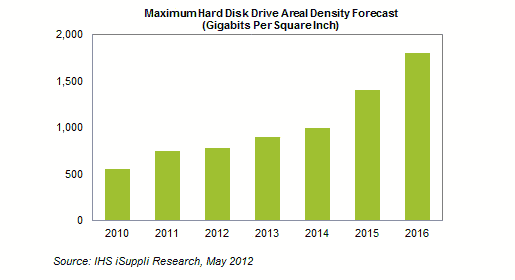Technology-centric market research company IHS iSuppli have published a new report in which they state they expect areal densities in hard disk drives (HDDs) to more than double from 2011 to 2016. The areal density of a HDD is measured by IHS in Gigabits per square inch and will be written as “Gb per square inch” throughout this article.
The current technology used in HDDs called perpendicular magnetic recording (PMR) is reaching its data density limits. Growth rates would have been higher otherwise. HDDs will still be a very important component, especially of desktop and media centre PCs, where high res video is recorded, edited and archived. Fang Zhang at IHS said “The rise in areal density will pave the way for continued growth of the HDD industry. Densities will double during the next five years, despite technical difficulties associated with the perpendicular magnetic recording (PMR) technology now used to create higher-areal-density hard disks. In particular, growth opportunities will lie in applications associated with mass enterprise storage requirements, gaming, and in digital video recorders (DVRs) where massive capacity is required to store high-definition video.”

The projected density in 2016 is approximately 1,800 Gb per square inch whereas this year we are expected to reach 780 Gb per square inch. Only 5 years ago the maximum HDD density was only 180 Gb per square inch.
Current PMR technology is estimated to only be workable up to the 1 Terabit (1,000 Gb per square inch) region, so how are manufacturers going to hit 1,800 Gb per square inch densities by 2016? The answer is through new technology, currently Seagate are working on a process called heat-assisted magnetic recording (HAMR) which they have used in the lab to reach densities of 1,000 Gb per square inch already. It’s an expensive technology at the moment but in theory “HAMR could extend HDD areal density to a range spanning 5 to 10 Tb per square inch” These figures for data density would give us 3.5 inch HDDs with capacities of up to 60 Terabytes. Higher densities give us better HDD performance too.
Though this report doesn’t mention them, it will be interesting to see where SSD technology is by 2016 and how people use both these storage technologies. Most power users want large storage capacity and high speed so hybrid configurations using both HDD and SSD will be more and more popular in systems, meeting both these needs at an attractive price.













